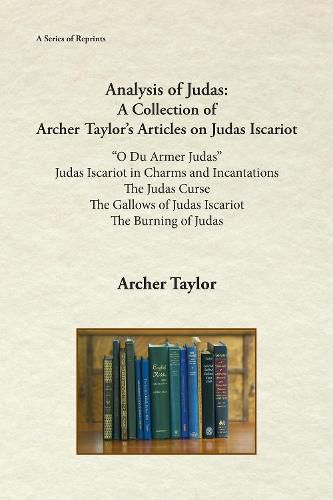Readings Newsletter
Become a Readings Member to make your shopping experience even easier.
Sign in or sign up for free!
You’re not far away from qualifying for FREE standard shipping within Australia
You’ve qualified for FREE standard shipping within Australia
The cart is loading…






O Du Armer Judas
The date of the origin of this song is very uncertain. There seems to be no record of the melody much before 1400; and the earliest documentary evidence of its satirical employment is nearly a hundred years later.
Judas Iscariot in Charms and Incantations
The name of Judas in charms is, I believe, always employed in connexion with some event in the life of Christ… . _ e most popular allusion is, as might perhaps have been expected, to the betrayal of the Savior or to the false kiss of the traitor.
The Judas Curse
This oath has, however, a very much wider distribution than is there indicated. It consists, in its briefest form, of the wish that the wrong-doer should share the lot of Judas (‘habeat portionem cum Iuda’); but, according to the mood of the user, this form may be much expanded by allusion to the great sinners of the Bible from Cain to Ananias and Sapphira.
The Gallows of Judas Iscariot
St. Matthew, with a reminiscence perhaps of Ahitophel’s death, says that Judas committed suicide by hanging himself. But in failing to record what sort of tree the traitor chose he left a lacuna for later tradition to fill. This uncertainty might, indeed, be settled if there were any agreement among those travellers who have in later times been fortunate enough to see the tree itself.
The Burning of Judas
In many countries the fi res which are lit at the coming of Spring are associated with Easter and with Judas. Sir J.G. Frazer and others have made it clear that these fi res are not of Christian origin, but are the remnants of pagan rites, now veiled under a Christian covering. Their original significance is still a disputed question.
Archer Taylor
$9.00 standard shipping within Australia
FREE standard shipping within Australia for orders over $100.00
Express & International shipping calculated at checkout
O Du Armer Judas
The date of the origin of this song is very uncertain. There seems to be no record of the melody much before 1400; and the earliest documentary evidence of its satirical employment is nearly a hundred years later.
Judas Iscariot in Charms and Incantations
The name of Judas in charms is, I believe, always employed in connexion with some event in the life of Christ… . _ e most popular allusion is, as might perhaps have been expected, to the betrayal of the Savior or to the false kiss of the traitor.
The Judas Curse
This oath has, however, a very much wider distribution than is there indicated. It consists, in its briefest form, of the wish that the wrong-doer should share the lot of Judas (‘habeat portionem cum Iuda’); but, according to the mood of the user, this form may be much expanded by allusion to the great sinners of the Bible from Cain to Ananias and Sapphira.
The Gallows of Judas Iscariot
St. Matthew, with a reminiscence perhaps of Ahitophel’s death, says that Judas committed suicide by hanging himself. But in failing to record what sort of tree the traitor chose he left a lacuna for later tradition to fill. This uncertainty might, indeed, be settled if there were any agreement among those travellers who have in later times been fortunate enough to see the tree itself.
The Burning of Judas
In many countries the fi res which are lit at the coming of Spring are associated with Easter and with Judas. Sir J.G. Frazer and others have made it clear that these fi res are not of Christian origin, but are the remnants of pagan rites, now veiled under a Christian covering. Their original significance is still a disputed question.
Archer Taylor